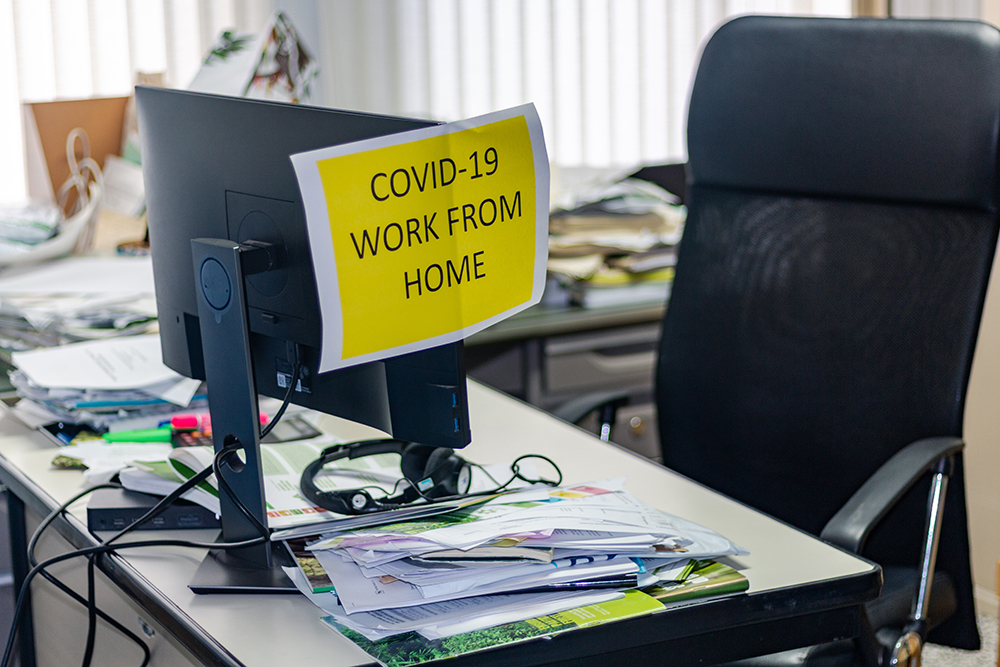

Features
Health & Safety
Mental Health
Working Remotely
How well are Canadian remote workers really doing?
By Amin Yazdani
 The faster that an employer can provide clarity to workers on future workplace arrangements, the more settled they can be that they want to be part of that future. (RON/Adobe Stock)
The faster that an employer can provide clarity to workers on future workplace arrangements, the more settled they can be that they want to be part of that future. (RON/Adobe Stock)
On March 11, 2020 the World Health Organization (WHO) declared COVID-19 a global pandemic. Since this announcement, working from home (WFH) has become a necessary measure to mitigate the potential transmission of the virus.
Millions of Canadians have had the way they live, work, and interact with their communities suddenly and significantly change.
Most of our knowledge about the impacts of WFH arrangements on health, well-being, productivity and performance comes from voluntarily WFH arrangements and little is known about the impacts of mandatory WFH arrangements.
To understand how this sudden WFH arrangement is impacting the health and well-being of our Canadian workforce, the Canadian Institute for Safety, Wellness & Performance (CISWP), hosted at Conestoga College’s School of Business, conducted a national survey between October and December 2020, in collaboration with La Trobe University in Australia.
During this timeframe, there was an average of 5,270 new cases of COVID-19 per day in Canada and many people had been in a mandatory WFH arrangement for over six months. Survey questions focused on stress and mental health, physical pain and discomfort, and work-life conflict.
Is transitioning to permanent remote work a good idea?
Survey says? Workers are worn out
More than 1,600 people participated in the survey and respondents represented a variety of industries, sectors, and main roles. Roughly 70 per cent identified as female and nearly 40 per cent had children.
Our preliminary analysis revealed that over 80 per cent of responders reported being worn out or tired at the end of the working day (indicative of burnout) and roughly 70 per cent of individuals felt tense or irritated while at work (suggestive of stress).
Interestingly though, just over one-third of people reported being more stressed and frustrated with work now, compared to pre-pandemic, and 40 per cent of individuals were more tired and exhausted.
Pandemic has skewed work-life balance
The survey also examined how Canadian WFH workforce are balancing their work and life responsibilities.
Through a series of questions related to work-life conflicts, the results indicate that people feel that work interferes with home responsibilities more often than home life interferes with work.
Nearly 40 per cent of people felt that the demands of work interfere with their home life.
These conflicts included work-related duties requiring that individuals make changes to their home/family plans and that job stress can make it difficult to fulfill home responsibilities.
It is also important to note that one quarter of respondents indicated that their work-life conflicts are worse now, compared to prior to the pandemic.
It is worth nothing that managers reported being more stressed, more burnt out and greater home-work conflict than non-managers. Additionally, those with children also reported being more stressed, more burnt out and greater work-life conflicts compared to individuals without caring responsibilities.
Musculoskeletal issues pervasive
With respect to signs and symptoms of musculoskeletal disorders, nearly 70 per cent of respondents reported experiencing pain or discomfort at the end of their working day.
This pain, typically reported as mild or moderate in nature, was most often experienced in the neck/shoulders and middle/low back regions of the body.
The high percentage of pain among the respondents may be attributed to the fact that during working hours, individuals reported spending an average of 83 per cent of their time sitting and excessive interaction with computers.
Additionally, one-third of people do not use an adjustable chair, and more than 35 per cent are working solely with a laptop with no secondary screens, mouse or keyboard. However, further analysis and investigation into the potential contributors to this pain is required.
Canadians want to work from home
Despite indications that some Canadians are experiencing feelings of burnout and stress, pain and discomfort, and work-life conflicts while in WFH arrangements, if given the option to WFH after the threat of COVID-19 subsides, over 70 per cent preferred to continue to WFH three or more days a week.
This result, although surprising at first glance, is supported by other research findings that remote workers expend more effort in their job, work longer hours, have more intense work per hour and put in more voluntary effort into their job, they still report higher job satisfaction and would choose to stay in their current role over a job that offers higher pay but is office-based.
A report of the preliminary results are available here. Full statistical analysis is currently underway, and the results will be made available following the conclusion of a follow-up survey, which CISWP will distribute in May.
Individuals who agreed to be contacted after completing the first survey will be contacted for the follow-up. The follow-up survey will aim to determine if and how their experiences have changed over time and results from both surveys will be used to help organizations develop suggestions and guidelines for supporting their WFH employees in the future.
CISWP is also conducting another study funded by Social Sciences and Humanities Research Council (SSHRC) to expand current knowledge on the impact of WFH arrangements on personal and organizational performance and productivity.
 Amin Yazdani is the director of the Canadian Institute of Safety, Wellness and Performance at Conestoga College in Kitchener, Ont.
Amin Yazdani is the director of the Canadian Institute of Safety, Wellness and Performance at Conestoga College in Kitchener, Ont.
This research project was led by Drs. Amin Yazdani, Marcus Yung, and research scientist Amy Hackney. For more information about the study findings or if you have any questions, please contact Yazdani or Hackney.
Print this page